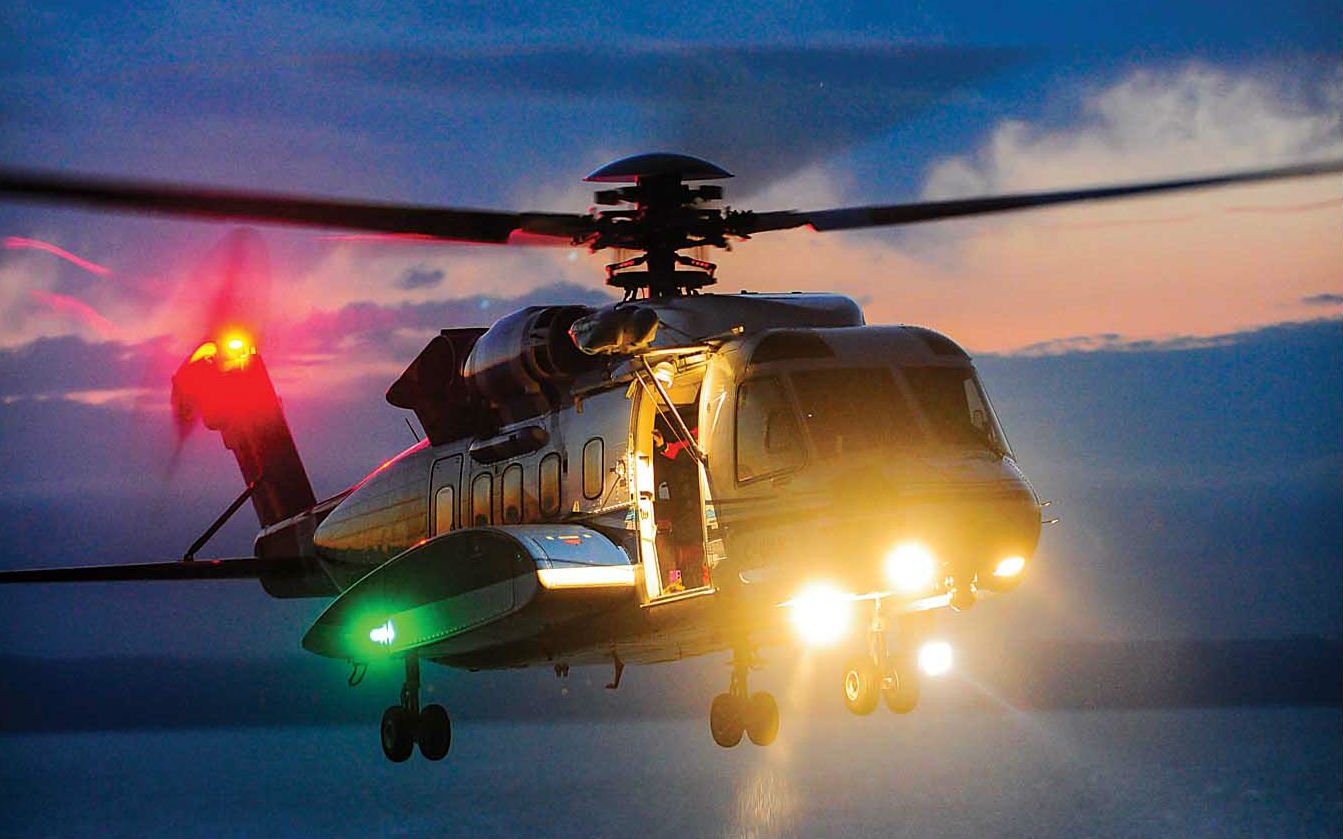There’s no getting away from it: these are challenging times for the helicopter industry. While those supporting the oil-and-gas sector have been the most directly affected by the downturn in oil prices, the knock-on effect has been felt throughout the industry, from original equipment manufacturers (OEMs) to maintenance, repair and overhaul facilities (MROs) and those offering ancillary products and services.

Which is perhaps why it’s refreshing to see someone in the industry — and especially someone working in the offshore oil-and-gas sector — that’s not only talking optimistically about the future, but preparing for the eventual upturn with a multimillion-dollar outlay. In November, Cougar Helicopters — a giant in the Canadian offshore oil-and-gas transport world — celebrated the grand opening of its new C$43-million headquarters in St. John’s, Newfoundland and Labrador. The facility has significantly increased its capacity to serve the oil-and-gas industry off Newfoundland’s coast, in a region that presents some of the most challenging conditions encountered by regular helicopter service anywhere in the world.
The new development spans two enormous buildings at St. John’s International Airport, with one containing a passenger processing terminal and the company’s offices, and the other a hangar and office space for the company’s maintenance team. Combined, the two facilities span close to 100,000 square feet, and, together with Cougar’s existing search-and-rescue (SAR) hangar and its two ramps, give the company a footprint of about 17.46 acres across the “Cougar campus” it has created at the airport.
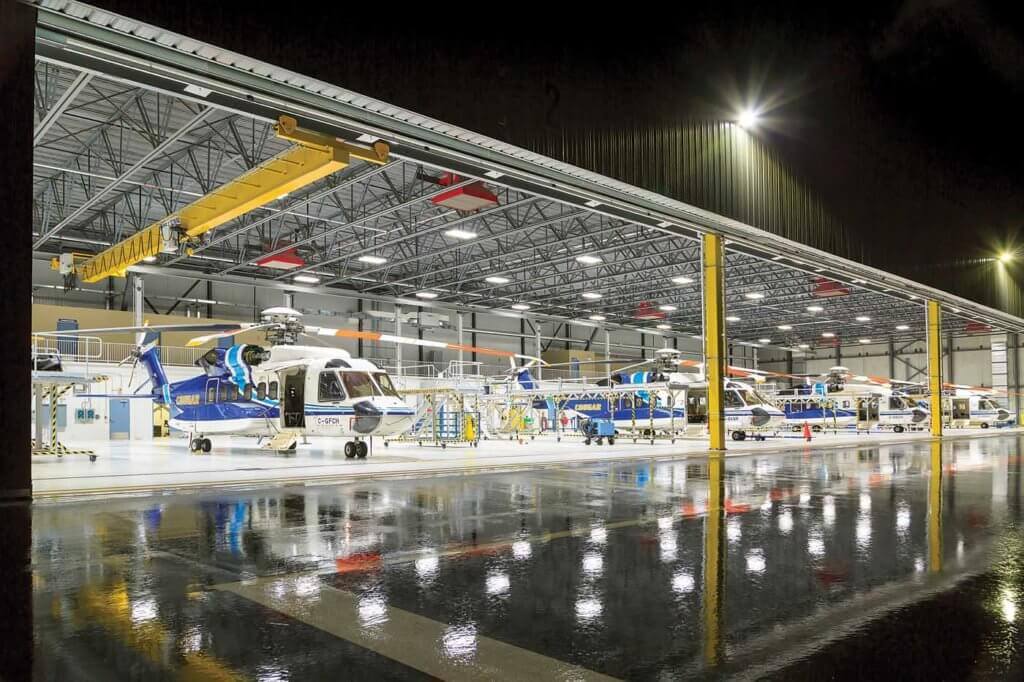
The buildings were officially opened Nov. 18 following a ribbon-cutting ceremony that saw Cougar’s chief operating officer, Hank Williams, joined by executives from parent company VIH Aviation Group, partner Bristow Group, oil company customers, and Newfoundland and Labrador Finance Minister Cathy Bennett.
“This facility is an investment in Cougar’s requirements for today, but I think more importantly, it is an investment in Cougar’s requirements for the future,” said Williams. “This facility is built with about 35 to 40 percent overcapacity for what we need for current operations. That represents Bristow, VIH and Cougar’s belief in Newfoundland and Labrador, and more specifically the oil-and-gas sector, and where we believe it is going — and we want to be front and center [for] the entire Newfoundland offshore industry.”
Setting the Standard
Cougar has been operating to oil-and-gas facilities off the coast of Newfoundland since it won a contract from ExxonMobil to service the Hibernia platform with an Airbus Helicopters Super Puma in 1996. From humble beginnings, it now has a staff of about 265, with four Sikorsky S-92s shuttling passengers between Newfoundland and offshore platforms, and a fifth S-92 in St. John’s for search-and-rescue operations on behalf of its customers. It also has two S-92s serving the offshore sector from its facility in Halifax, Nova Scotia. And over the more than 20 years it has been conducting offshore operations, it has learned a lot.

“When Newfoundland first got into the oil-and-gas business, we saw a lot of people coming here from the North Sea or from the States [to offer their experience],” Williams told Vertical. “There’s a lot less of that now because we developed our own expertise. Our standards are as high as they are anywhere in the world — if not higher in some areas.”
Cougar’s gradual expansion over the years caused it to fill its previous facility in St. John’s, eventually needing to use some of the office space at the purpose-built SAR hangar it constructed at the airport in 2012.
The company developed a partial SAR capability soon after launching its first offshore service, but the SAR service as it exists today came into being following the fatal crash of Cougar flight 491 off the coast of Newfoundland. The official enquiry that followed the accident determined that there was an urgent need for a SAR operation dedicated to the offshore industry; one that could crucially reach people in an emergency situation in a drastically reduced time.

Fully funded by oil companies, the service is provided from its own 27,500-foot hangar, with a specially-equipped aircraft and highly-trained rescue pilots and crews. The service provides for a 20-minute response time.
Fully compatible with night vision goggles, the SAR aircraft has a FLIR Ultra 8500XRT forward looking infrared camera, a 30-million candle power Spectrolab Nightsun searchlight, a custom-built FLIR station/communications hub, full triage, oxygen air, respiratory distress, burn and hypothermic treatment kits, as well as tools for cardiopulmonary resuscitation (CPR) and a defibrillator.

In addition to this, it carries two survival kits that can be deployed from the air, each consisting of a 10-man life raft, and 250 feet of floating polypropylene rope connected to a supply bundle. The team uses a Goodrich dual rescue hoist, with 300 feet of usable cable and a maximum weight of 600 pounds — but with an overload capacity of 1,100 pounds. The rescue slings have a built-in strop to prevent a person slipping through, while a rescue basket and Stokes litter complete the recovery equipment carried. Two auxiliary fuel tanks allow the SAR team to take an extra 1,000 pounds of fuel, and provide the S-92 with an operating range of 290 nautical miles, with 30 minutes on the scene. Offshore refueling can increase this range if necessary.
Cougar works closely and keeps in regular contact with Canada’s official SAR service in the region — the Royal Canadian Air Force’s 103 Search and Rescue Squadron, and the Joint Rescue Coordination Centre (JRRC) in Halifax — and organizes annual training exercises with the unit.
Cutting Edge Facilities
When the oil companies for whom Cougar had been flying issued a new tender for service in 2014, the work scope of the contracts helped serve as the catalyst for Cougar’s headquarters and passenger processing facility to make the move to a new home.

“The definition of the services we had to deliver was very clear that we could not do that from our old facility,” said Williams.
Planning for the new facility began about three years ago during preparation for Cougar’s response to the oil companies’ request for proposals, with construction starting in December 2014. Cougar contracted Lindsay Construction to build the facility; the two had previously worked together on Cougar’s SAR hangar in St. John’s and its passenger handling facility/office in Halifax.
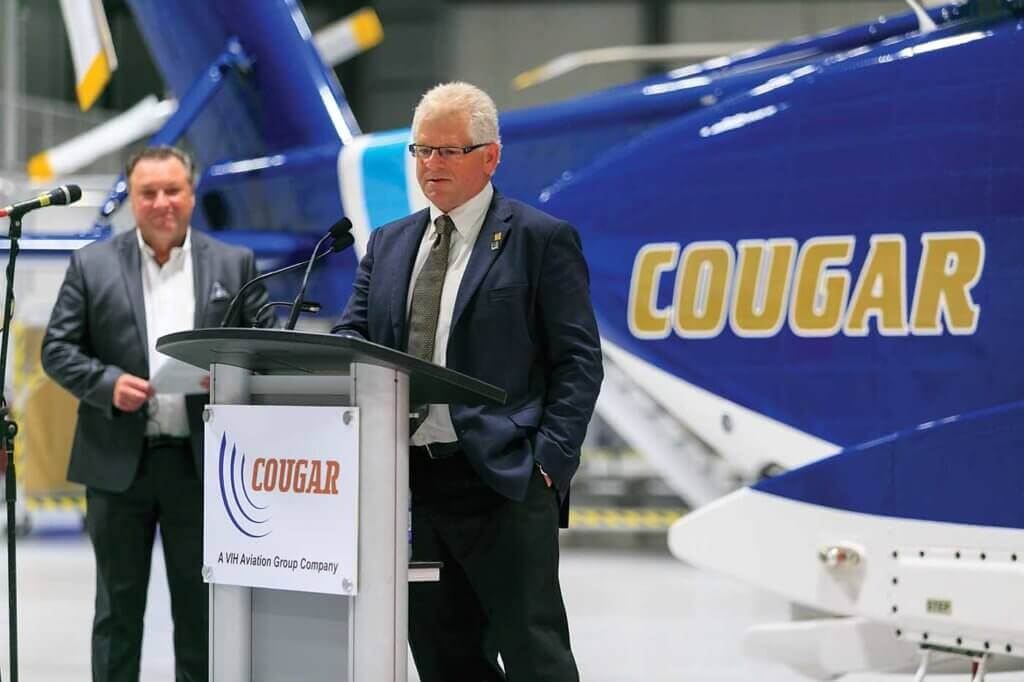
“Over the past two projects, Lindsay acquired a knowledge of our operations and what we are doing,” Allan Knight, Cougar’s project manager for the construction of the facility, told Vertical. “So the two companies worked really well in identifying what needed to be done in the initial stages, and that helped a great deal in the reduction of change orders.”
This experience allowed construction to be completed well ahead of schedule — six months early for the passenger terminal, and three months early for the hangar.
From its external appearance to the flow of people through the building, the new passenger building closely resembles a terminal at a commercial airport, with clearly demarcated and separate departure and arrival areas for passengers and family — and a third separate entrance for staff and office visitors to access the administration offices above.
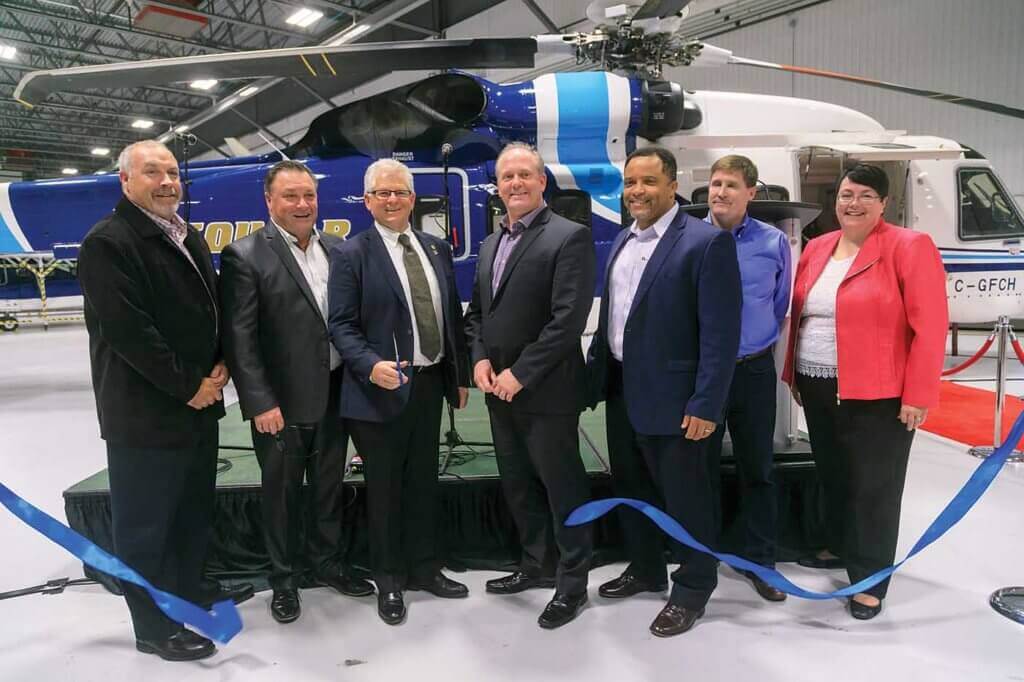
The facility has six briefing rooms and four check-in counters — as compared to two in Cougar’s previous passenger building — which will allow it to process up to four flights simultaneously. Central to the facility is a large seating area with several TVs, which is flanked by several rooms aimed to increase the comfort of passengers, including a games room, a communications/internet room, a quiet/rest room, and a lunchroom.
“The unfortunate thing with Newfoundland is our weather, so some people are here for longer periods of time,” said Knight. “We accommodate our passengers as much as possible in terms of comfort. While the oil companies are our customers, the people that travel offshore — they are also our customers. They have to be happy, they have to be comfortable, and above all they have to be safe.”
Next door, the maintenance hangar may not look as attractive on the exterior, but it contains some of the most cutting-edge facilities in the helicopter industry. The cavernous building is large enough to fit five Sikorsky S-92s side by side without requiring any intermeshing of blades.

LED lighting provides energy efficiency, while underfloor heating keeps the workplace comfortable — and avoids the risk of ice buildup on the building’s fringes. Running underneath a mezzanine at the rear of the hangar are rooms (some with anti-static flooring) for various departments and maintenance activities — including a composites room; an avionics room; a petroleum, oils, and lubricants room; a battery room; fire suppression room and, underneath the maintenance offices at the far end of the building, a tool control room. An overhead crane spans the width of the hangar (350 feet), allowing it to be used by mechanics working in every bay. Each bay also has access to an in-ground Cavotec utility system that contains everything the maintenance teams need to power and work on the aircraft, meaning cables don’t need to be pulled across the floor from the wall.
“We learned a lot of lessons from the other hangars we have operated out of, and we were trying to make the job as easy and as efficient as possible, so there was a lot of input from everybody as to what they would like to see in this hangar,” said Bob Pardy, Cougar’s maintenance manager.
This included rethinking the water drainage grates, which had been at the center of a slight incline in the middle of the floor in the previous hangar.
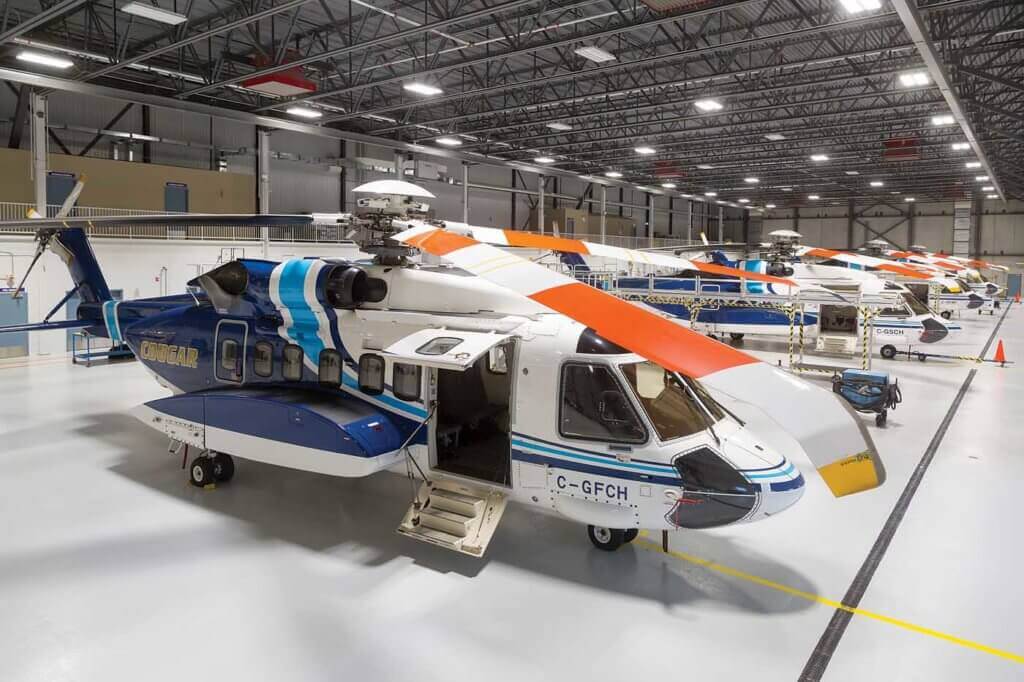
“It made it difficult to put jacks on the floor to jack the aircraft level and keep the jack level,” said Pardy. “So we put the drainage grate out the front of the hangar, just inside the hangar doors a bit, and the floor has a very small grade that goes out to that. When we get a jack on the hangar floor now to jack an aircraft, they are level on the floor, and the aircraft comes up much more level, and the jacks are much safer.”
Building for Growth
Williams said that despite challenging times in the offshore industry, Cougar has managed to stay somewhat insulated due to the fact that the vast majority of the work it’s supporting is production rather than exploration — and it’s the latter that has been severely cut by oil companies.
“This downturn hasn’t changed the requirement for production activities,” said Williams. “But it’s impacting us from the point of view that it’s more of a need today — even for the contractors — to reduce [the oil companies’] costs, so we’ve been working together with them on reducing their costs.”
Together with this, it is focusing its efforts on ensuring it will be in the best position possible to win new contracts in the future.
“Having the right facilities does give you a competitive advantage in the marketplace, and it comes with a lot of belief and investment,” said Williams. “Part of my role over the last two or three years was going to my board of directors and asking for the money to do this, and at the same time, there’s a downturn in the industry. So it was about the belief in the future and the opportunities here on the east coast of Canada, and the belief that our future required this.”

That belief is such that the foundations are already in place for a second five-bay hangar on the other side of Cougar’s new maintenance offices.
“Typically in this business, you might get six-to-eight months’ notice that there’s a contract requirement coming up and aircraft are needed,” said Williams. “So what we did is spend a fair amount of money prepping the second portion of the hangar so that within a year to 14 months, we could have that other building up quickly. We are poised to push that button as soon as the next project says we need that space.”
Together with the new multimillion-dollar simulator and research center built and operated by CAE just a few miles down the road from Cougar in Mount Pearl, those working in the helicopter industry in Newfoundland now have access to some of the finest facilities in the world.
“There’s still people investing in this province, in this industry, that see the future,” said Williams. “It’s always difficult when you talk about the future, because we’ve probably got companies and people worried about the next six months, but as a company the size of ours and what we do in offshore oil-and-gas, you’ve got to look beyond at what the next five, 10 years looks like. And we believe in Newfoundland and Labrador.”





